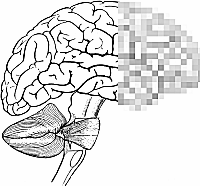 I’ve suggested previously that one of the important features of qualia (the redness of red, the smelliness of Gorgonzola, etc) is haecceity, thisness. When we experience redness, it’s not any Platonic kind of redness, it’s not an idea of redness, it’s that. When people say there is something it is like to smell that smell, we might reply, yes: that. That’s what it’s like. The difficulty of even talking about qualia is notorious, I’m afraid.
I’ve suggested previously that one of the important features of qualia (the redness of red, the smelliness of Gorgonzola, etc) is haecceity, thisness. When we experience redness, it’s not any Platonic kind of redness, it’s not an idea of redness, it’s that. When people say there is something it is like to smell that smell, we might reply, yes: that. That’s what it’s like. The difficulty of even talking about qualia is notorious, I’m afraid.
But it occurred to me that there was another problem, not so often addressed, which has the same characteristic: the problem of one’s own haecceity.
Both problems are ones that often occur to people of a philosophical turn of mind, even if they have no academic knowledge of the subject. People sometimes remark ‘For all we know, when I see the colour blue, you might be seeing what I see when I see red’, and similarly, thoughtful people are sometimes struck by puzzlement as to why they are themselves and not someone else. That particular problem has a trivial interpretation – if you weren’t you, it would be someone else’s problem – but there is a real and difficult issue related to the grand ultimate question of why there is anything at all, and why specifically this.
One of the standard arguments for qualia, of course, is the possibility of philosophical zombies, people who resemble us in every way except that they have no qualia. They talk and behave just like us, but there is nothing happening inside, no phenomenal experience. Qualophiles contend that the possibility of such zombies establishes qualia as real and additional to the normal physical story. Can we have personhood zombies, too? These would be people who, again, are to all appearances like us, but they don’t have any experience of being anyone, no sense of being a particular self. It seems at least a prima facie possibility.
That means that if we consider both qualia and selfhood, we have a range of four possible zomboid variants. Number one, not in fact a zombie at all, would have both qualia and the experience of selfhood – probably what the majority would consider the normal state of affairs. His opposite would have neither qualia nor a special sense of self, and that would be what a Dennettian sceptic takes to be the normal position. Number three has a phenomenal awareness of his own existence, but no qualia. This is what I would take to be the standard philosophical zombie. This is not really clear, of course: I assume the absence of discussion of the self in normal qualia discussion implies that zombies are normal in this respect, but others might not agree and some might even be inclined to regard the sense of self as just a specific example of a quale (there are, presumably, proprioceptive qualia, though I don’t think that’s what I’m talking about here), not really worthy of independent discussion.
It’s number four that really is a bit strange; he has qualia going on inside, but no him in him: phenomenal experience, but no apparent experiencer. Is this conceivable? I certainly have no knock-down argument, but my inclination is to say it isn’t: I’m inclined to say that all experiences have an experiencer just as surely as causes have effects. If that’s true, then it suggests the two cases of haecceity might be reducible to one: the thisness of your qualia is really just your own thisness as the experiencer (I hope you’re still with me here, reader). That in turn might mean we haven’t been looking in quite the right place for a proper account of qualia.
What if number four were conceivable? If qualia can exist in the absence of any subjective self-awareness, that suggests they’re not as tightly tied to people as we might have thought. That would surely give comfort to the panpsychists, who might be happy to think of qualia blossoming everywhere, in inanimate matter as well as in brains. I don’t find this an especially congenial perspective myself, but if it were true, we’d still want to look at personal thisness and how it makes the qualia of human beings different from the qualia of stones.
At this point I ought to have a blindingly original new idea of the metaphysics of the sense of self which would illuminate the whole question as never before. I’m afraid I’ll have to come back to you on that one.

 A bit of an
A bit of an  More about babies – of a sort. You may have seen
More about babies – of a sort. You may have seen